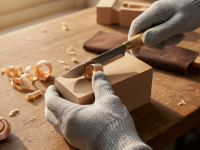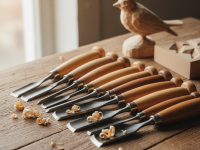Hey there, fellow wood enthusiast! There’s something truly magical about taking a flat piece of wood and transforming it into a three-dimensional work of art, isn’t there? Relief carving, in particular, offers such a satisfying blend of sculpting and drawing. You’re bringing depth and texture to life, telling a story right there on the surface.
But let’s be honest, when you first step into the world of wood carving tools, it can feel a little overwhelming. Rows upon rows of chisels, gouges, V-tools – each with its own mysterious curvature and number. How do you even begin to choose? Especially when you’re focusing specifically on relief carving, where precision and variety are key.
I’ve been there, fumbling through sets, wondering why some tools felt just right while others seemed utterly useless for what I wanted to achieve. Over time, through countless hours of carving, experimenting, and yes, making a few mistakes, I’ve learned a thing or two about selecting the right gouges for relief work. And today, I’m here to share those insights with you. Think of this as a friendly chat over a workbench, helping you navigate the exciting journey of building your ideal carving toolkit.
Understanding the Basics: What Exactly *Is* a Gouge?
Before we dive deep, let’s clarify what we’re talking about. In simple terms, a gouge is a wood carving tool with a curved blade. This curvature is its defining characteristic and what sets it apart from a flat chisel. For relief carving, these curves are absolutely essential because they allow you to create rounded forms, scoop out material, define contours, and generally sculpt the three-dimensional shapes that bring your piece to life.
You’ll encounter various forms of gouges: straight gouges, bent gouges (which have a curve along their length), spoon gouges (very deeply bent for getting into tight spots), and fishtail gouges (which have a narrow shank that flares out at the blade, offering better visibility and reach). For relief carving, a combination of these will be your best friends.
The Anatomy of a Gouge: Sweep, Width, and Grind
When you pick up a gouge, you’ll usually see numbers stamped on it. These numbers aren’t just arbitrary; they tell you everything you need to know about that tool’s specific characteristics.
1. Sweep (Curvature)
This is arguably the most crucial aspect for relief carving. The “sweep” refers to how much the blade curves. It’s typically represented by a number:
- Lower Sweeps (#2 – #4): These are nearly flat. Think of them as slightly curved chisels. I find them incredibly useful for clearing backgrounds, leveling large areas, and creating subtle, gentle curves. If you need to remove a lot of material from the background quickly, a wide, low-sweep gouge is your go-to.
- Medium Sweeps (#5 – #7): These are your workhorses. They have a more pronounced curve, making them perfect for general shaping, refining contours, and creating smooth transitions. When I’m developing the main forms of a design, these are the tools I reach for most often. A #5 or #7 in a medium width is a fantastic starting point for almost any relief project.
- High Sweeps (#8 – #11): Now we’re getting into deeper curves, almost U-shaped. These are excellent for creating pronounced concave forms, undercutting, and working on tighter, more defined curves. For instance, if you’re carving a flower petal and need that deep, organic curve, a high-sweep gouge will do the trick.
- V-Tools (#12 – #16, or angled): While technically a type of chisel, V-tools are indispensable for relief carving. They create crisp lines and sharp V-shaped cuts. They’re perfect for outlining your design, adding texture, and defining details like hair or fur. They come in various angles (e.g., 60-degree, 90-degree) and sweeps (how deep the ‘V’ is). I always recommend having at least one good V-tool in your arsenal.
When I first started, I thought bigger sweep numbers meant bigger tools. Boy, was I wrong! It’s all about the curve. A common mistake I saw begiers make (and I made it too!) was trying to force a low-sweep gouge to do the work of a high-sweep, leading to frustration and often, damaged wood. Matching the sweep to the curve you want to create is key.
2. Width
The width of the gouge refers to the cutting edge’s dimension, usually measured in millimeters or inches. Just like with sweeps, you’ll want a range of widths:
- Wide Gouges (15mm+): Great for clearing large background areas, making broad, sweeping cuts, and quickly removing material.
- Medium Gouges (8-14mm): These are your versatile general-purpose tools, good for most shaping tasks.
- Narrow Gouges (1-7mm): Essential for intricate details, tight spaces, fine lines, and delicate textures.
You’ll quickly find that one 10mm #5 isn’t enough; you’ll want a 3mm, a 6mm, maybe even a 20mm of that same sweep. Having a variety of widths for your most-used sweeps significantly expands your carving capabilities.
3. Grind (Bevel)
This refers to the angle at which the cutting edge is sharpened. Most gouges for wood carving have an outer bevel (the flat side is on the inside of the curve, the bevel on the outside). Some specialized gouges might have an ier bevel, but for relief carving, you’ll primarily be working with outer bevels. The most important thing about the grind is that it must be razor-sharp. A dull tool is not just frustrating; it’s dangerous and damages your wood, making clean cuts impossible.
Starting Your Toolkit: Essential Gouges for Begiers
My advice to anyone starting out: don’t buy the biggest, most expensive set you can find. You’ll end up with tools you rarely use, and it’s better to invest in a few high-quality, versatile pieces than a large set of mediocre ones. My first set was a mismatched collection from a garage sale, and while it taught me a lot, starting with a few quality essentials would have been much smoother.
For relief carving, I recommend starting with:
- A couple of medium-sweep gouges (#5 or #7) in different widths (e.g., 8mm and 15mm): These will be your main workhorses for shaping.
- A flat or low-sweep gouge (#2 or #3, around 15-20mm): Crucial for background removal and flattening areas.
- A V-tool (e.g., 60-degree, 6-10mm): Absolutely essential for outlining your design.
- A detail gouge (e.g., #9 or #10, 3-5mm): For getting into smaller areas and adding finer detail.
With these five or six tools, you can accomplish a surprising amount. As you gain experience, you’ll naturally discover what other sweeps and widths you need for the specific projects you enjoy most.
Expanding Your Horizons: Specialized Gouges for Advanced Relief
Once you get comfortable with the basics, you’ll start eyeing those specialized tools that can elevate your work. My own journey saw a dramatic improvement when I added certain specialized gouges. A good long-bent gouge, for example, changed my background clearing game completely!
- Bent Gouges (Spoon, Long Bent): These are fantastic for reaching into deep concave areas and undercutting where a straight gouge just can’t go. Spoon gouges have a very pronounced bend close to the tip, while long-bent gouges have a more gradual curve along the shaft.
- Fishtail Gouges: These have a narrow shank that widens out to a broader cutting edge, like a fish’s tail. The narrow shank offers better visibility of your cut, and the wider blade allows for efficient material removal in tight spots. I find them incredibly useful for clearing backgrounds around intricate details.
- Back-Bent Gouges: These are specialized for carving reverse curves or concave areas that bend back towards the carver. They’re less common but invaluable for specific tasks.
- Fluting Gouges: Designed to create consistent, decorative grooves, often used for architectural details or textured backgrounds.
Quality Matters: Choosing the Right Brand and Steel
I learned the hard way that cheap tools often mean more frustration than savings. Invest in quality; your hands and your wood will thank you. Here’s what to look for:
- Steel Quality: High-carbon steel is common and holds a good edge, but chrome vanadium steel is often preferred for its excellent edge retention and resistance to wear, making it a joy to sharpen and use.
- Handle Comfort: You’ll be spending hours holding these tools. A comfortable, ergonomic handle (usually made of wood) is crucial to prevent hand fatigue and allow for precise control.
- Reputable Brands: While I won’t recommend one specific brand over another, know that names like Pfeil, Flexcut, Henry Taylor, and Robert Sorby are renowned for producing high-quality carving tools that will last a lifetime with proper care. Do a little research, read reviews, and consider what fits your budget.
Sharpening: The Non-Negotiable Step
This isn’t about choosing gouges, but it’s so vital it deserves a mention. Even the most expensive, perfectly chosen gouge is useless if it’s dull. My carving improved dramatically the moment I truly understood and committed to proper sharpening. Invest in a good sharpening setup – a few sharpening stones (oil or water stones), leather strops, and slip stones (shaped stones for sharpening the inside curve of a gouge). Learning to sharpen properly will make all your carving tools perform at their best and significantly enhance your carving experience.
Conclusion: Your Carving Journey Awaits!
Choosing wood carving gouges for relief carving isn’t about finding a magic bullet; it’s about building a versatile toolkit that supports your creative vision. It’s an ongoing journey of discovery, where each new project might prompt you to try a new sweep or width. Don’t be afraid to experiment, trust your instincts, and gradually expand your collection as your skills and projects evolve.
Remember, the right tools don’t just make carving easier; they empower your creativity, allowing you to bring those intricate designs and beautiful textures to life with greater precision and joy. So, go forth, choose wisely, and let your hands transform that humble piece of wood into something truly extraordinary!


